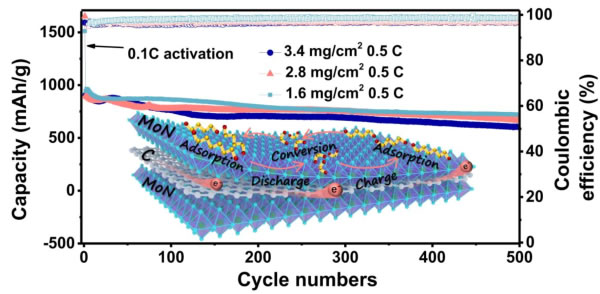Lithium-sulfur batteries (Li-S) have a higher theoretical energy density (2500 Wh/kg) than traditional lithium-ion batteries, and are expected to become the most energy storage applications in the future (including large-scale smart grids, electric vehicles, and mobile electronic devices, etc.) One of the promising candidate systems. In recent years, people have proposed a variety of strategies to try to commercialize lithium-sulfur batteries, such as the development of new cathode composite materials, intermediate or separator decoration, multi-functional binders, and electrolyte additives. Among them, the microstructure design for sulfur cathodes can produce the most direct localization effect on sulfur-based active materials. The introduction of polar host materials can further enhance the chemical adsorption of lithium polysulfide, thereby improving the battery cycle stability. However, the inherent low electronic conductivity of non-carbon polar hosts usually leads to low sulfur utilization, especially when the sulfur distribution is uneven under high loads. This disadvantage is more prominent, so explore more polar host materials with more conductivity And its full contact with the carbon skeleton is necessary. Recently, Li Chilin, a researcher at the Shanghai Institute of Ceramics, Chinese Academy of Sciences, and Yang Minghui, a researcher at the Ningbo Institute of Materials Technology and Engineering, Chinese Academy of Sciences, designed a catalyst-carbon-catalyst "sandwich" structure with a compact two-dimensional catalytic-conductive interface sulfur host Materials, lithium-sulfur batteries that achieve high stability, and related results were published in the international academic journal Angewandte Chemie (2020, doi.org/10.1002/anie.202004048). The d-orbitals of metal nitrides overlap each other, and their electronic conductivity is comparable to that of metals, and they are ideal polar materials in terms of adsorbing lithium polysulfides, and have the effects of promoting charge transfer and potential electrocatalysis. However, metal nitrides have a limited recombination method in the carbon skeleton, usually only the point-point or point-plane contact of the nano-particle nitride with the carbon skeleton, the contact area is limited, so that the charge transport ability is limited, so the establishment of polar host particles (Or site) a continuous interface with sufficient contact with the carbon skeleton (face-to-face contact) is still a challenge. In addition, unloaded and non-polar volume spaces usually occupy a high proportion in the loose sulfur host framework, and the point contact between discrete catalyst nanocrystal domains and conductive substrates cannot reduce the proportion of such non-catalytically active spaces, This phenomenon will hinder the development of high-capacity lithium-sulfur batteries. Reasonable positive electrode design and microstructure recombination can minimize the no-load and non-polar volume space, which is expected to promote the development of compact lithium-sulfur batteries. Based on this, the team proposed a MoN-C-MoN "sandwich" host structure with continuous two-dimensional catalytic-conductive interface, which has both catalytic and electron transfer functions, as a sulfur cathode host material for lithium-sulfur batteries. This three-layer structure exists in the single nanosheet particles along the thickness direction, which promotes the strong conformal adsorption and efficient conversion of S/Li2Sx on the polar surface of the double-sided outer nitride layer, and the high-throughput electron transfer of the middle carbon interlayer . These two-dimensional “sandwich†structural units can further self-assemble into an ordered three-dimensional texture, which further strengthens the interconnection of the conductive network and the catalytic network. Even if the specific surface area of ​​the host skeleton is low (97 m2/g), the maximum exposure of the adsorption/catalysis plane makes the MoN-C@S electrode at high S load (75.7 wt%) and 1C (1C = 1672 mA/g) rate It can still cycle steadily for at least 1000 cycles, and the capacity decay rate per cycle is only 0.033%. Even at a high rate of 4C, the specific capacity can be maintained at 515 mAh/g. After increasing the S content to 3.4 mg/cm2, the compact sulfur host of this three-layer structure still showed good electrical conductivity, and its capacity was still maintained at 604 mAh/g after 500 cycles. This cooperative working mode between catalytic and conductive functions ensures the uniform deposition of S/Li2Sx, avoiding their thickening and deactivation (electrode passivation) after high magnification and long-term cycling. The chelation-ammonization method reported in this work provides guarantee for the ordered separation of C and MoN phases and surface-to-surface contact, and also provides a new synthesis method for the preparation of two-dimensional nitrides. The above research work has received funding and support from the National Key R&D Program and the National Natural Science Foundation of China. Silk Printed Tempered Glass,Silk Screen Printing Glass,Tempered Silk Screen Glass,Tempered Printed Glass Shanghai Lead Glass Co.,Ltd , https://www.leadglaze.com
Catalyst-carbon-catalyst "sandwich" structure as a compact two-dimensional sulfur host material to boost high-stability lithium-sulfur batteries